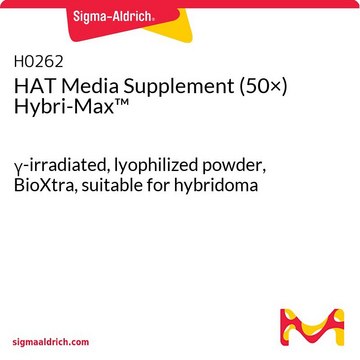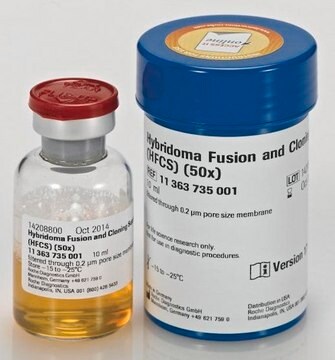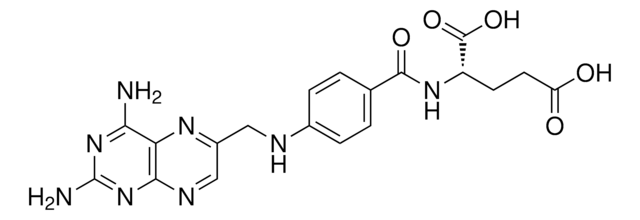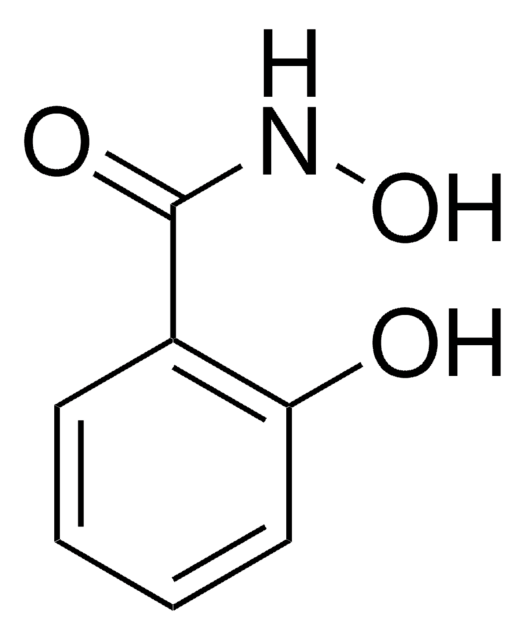P7306
Polyethylene glycol/ dimethyl sulfoxide solution
Hybri-Max™, average mol wt 1,450, 50 % (w/v), 0.2 μm filtered, BioReagent, suitable for hybridoma
Sinonimo/i:
PEG/DMSO Solution, Polyethylene Glycol Solution, Solution of PEG and DMSO
Autenticatiper visualizzare i prezzi riservati alla tua organizzazione & contrattuali
About This Item
Prodotti consigliati
Grado
Hybri-Max™
Livello qualitativo
Sterilità
0.2 μm filtered
Nome Commerciale
BioReagent
Stato
solution
PM
average mol wt 1,450
Concentrazione
50 % (w/v)
tecniche
cell culture | hybridoma: suitable
Impurezze
endotoxin, tested
Temperatura di conservazione
2-8°C
Stringa SMILE
C(CO)O
InChI
1S/C2H6O2/c3-1-2-4/h3-4H,1-2H2
LYCAIKOWRPUZTN-UHFFFAOYSA-N
Applicazioni
PEG is used as a fusogen to obtain hybridomas for monoclonal antibody production. Induces cell hybridization.
Recommended for use in a normal fusion protocol requiring 50% PEG and 10% DMSO.
Recommended for use in a normal fusion protocol requiring 50% PEG and 10% DMSO.
Confezionamento
Packaged in sealed ampules under nitrogen.
Altre note
Contains 50% (w/v) polyethylene glycol (Av. Mol. Wt. 1450) and 10% DMSO (v/v) in DPBS without Calcium.
Ricostituzione
Solution is ready-to-use. If a less concentrated solution is desired, dilute with sterile DPBS without calcium (D5773). Some precipitate may appear after being exposed to cooler, but should disappear as the solution warms. Solution may be frozen if desired but should first be aliquotted to avoid repeated freeze/thaw cycles.
Note legali
Hybri-Max is a trademark of Sigma-Aldrich Co. LLC
Codice della classe di stoccaggio
10 - Combustible liquids
Classe di pericolosità dell'acqua (WGK)
WGK 1
Punto d’infiammabilità (°F)
Not applicable
Punto d’infiammabilità (°C)
Not applicable
Scegli una delle versioni più recenti:
Possiedi già questo prodotto?
I documenti relativi ai prodotti acquistati recentemente sono disponibili nell’Archivio dei documenti.
I clienti hanno visto anche
Wen-Hung Chen et al.
Virology journal, 14(1), 189-189 (2017-10-04)
Dengue virus (DV) infection causes a spectrum of clinical diseases ranging from dengue fever to a life-threatening dengue hemorrhagic fever. Four distinct serotypes (DV1-4), which have similar genome sequences and envelope protein (E protein) antigenic properties, were divided. Among these
Wei Guo et al.
Neurobiology of disease, 132, 104590-104590 (2019-08-31)
While Brain-derived Neurotrophic Factor (BDNF) has long been implicated in treating neurological diseases, recombinant BDNF protein has failed in multiple clinical trials. In addition to its unstable and adhesive nature, BDNF can activate p75NTR, a receptor mediating cellular functions opposite
Indre Kucinskaite-Kodze et al.
Biomolecules, 10(7) (2020-07-12)
The pathogenicity of many bacteria, including Streptococcus pneumoniae, depends on pore-forming toxins (PFTs) that cause host cell lysis by forming large pores in cholesterol-containing cell membranes. Therefore, PFTs-neutralising antibodies may provide useful tools for reducing S. pneumoniae pathogenic effects. This
Liliana R Loureiro et al.
Scientific reports, 8(1), 12196-12196 (2018-08-17)
Incomplete O-glycosylation is a feature associated with malignancy resulting in the expression of truncated glycans such as the sialyl-Tn (STn) antigen. Despite all the progress in the development of potential anti-cancer antibodies, their application is frequently hindered by low specificities
Sondra T Bland et al.
Brain, behavior, and immunity, 23(4), 492-497 (2009-06-03)
Glial activation has recently been discovered to modulate several effects of morphine, including analgesia, tolerance, and dependence. The present studies extend this line of investigation by exploring whether glial activation may also affect extracellular levels of dopamine (DA) in the
Il team dei nostri ricercatori vanta grande esperienza in tutte le aree della ricerca quali Life Science, scienza dei materiali, sintesi chimica, cromatografia, discipline analitiche, ecc..
Contatta l'Assistenza Tecnica.








